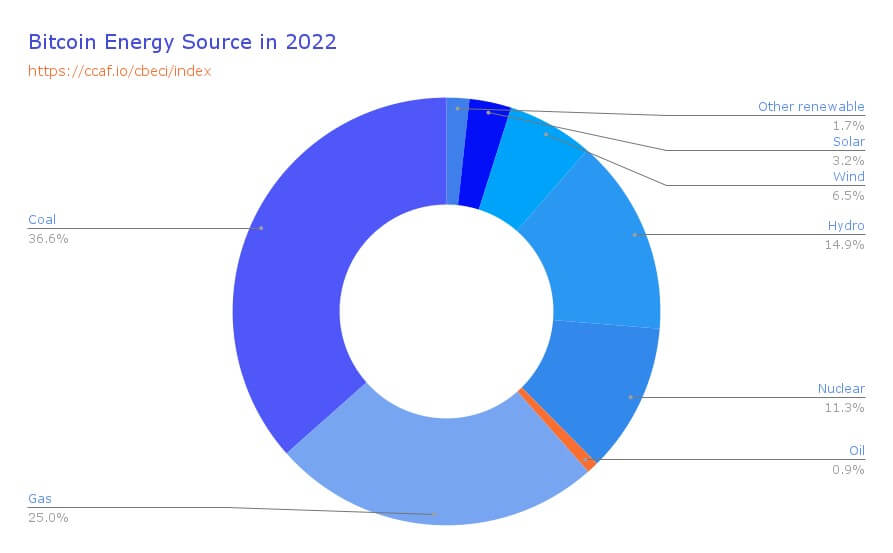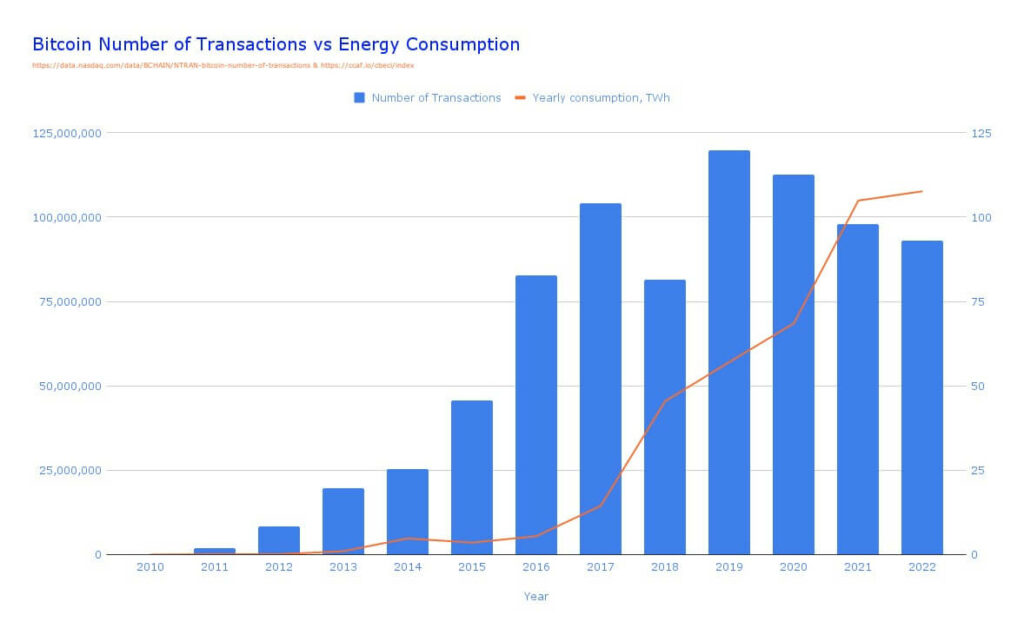Bitcoin Energy Consumption Statistics
Last Updated on December 24, 2023 by Kevin GrovesIt’s no secret that cryptocurrency has an energy consumption issue. Bitcoin alone consumes more energy annually than Finland’s 5.5 million population and is predicted to keep rising.
There are many options for Bitcoin to decarbonise the industry and reduce its energy-intensive expenditure but it may take decades to be achieved. In this article, we’re going to reflect on the following:
- How much energy does Bitcoin use?
- Why is it so energy intensive?
- What is the environmental impact of Bitcoin mining?
- The energy types available for Bitcoin.
- The Difference Between Using and Mining Bitcoin.
- Bitcoin vs. Other Industries’ Energy Consumption.
- Historical Bitcoin Energy Usage.
How Much Energy Does Bitcoin Use?
Here are some key facts about Bitcoin’s energy usage.
- In 2016, Bitcoin’s yearly electricity consumption was 5.46 Terawatt Hours per year (CCAF).
- In 2023, the energy consumption averages 129 TWh per year (CCAF).
- It contributes to around 0.4% to 0.9% of global electricity production (Whitehouse).
- On average, Bitcoin uses 707 kilowatt-hours (kWh) of electricity per transaction which is 11 times more compared to Ethereum, another leading token in the industry (CCAF).
- At the start of 2021, Bitcoin alone generated more e-waste than several mid-sized countries, according to Paris-based economist Alex De Vries (Fintech).

Of course, Bitcoin isn’t the only cryptocurrency that poses a significant environmental burden. But its popularity means that, when compared to other digital currencies, Bitcoin consumes the lion’s share.
Many attribute Bitcoin’s enormous environmental impacts to its uniquely inefficient mechanisms, but some also say it’s purely due to its popularity.
Whichever the case, the environmental burden of digital currencies is becoming a worrying factor for many, with some suggesting that underlying blockchain technology can be the key to a greener future for Bitcoin.
Why Does Bitcoin Use So Much Energy?
There are 5 major reasons why Bitcoin uses so much energy:
- Mining Bitcoin today requires enormous amounts of capital. Unlike the early days when anyone with a home computer could easily mine Bitcoin; it now requires a mass amount of highly specialised machines, and enough cooling power to prevent hardware from overheating.
- The continuous development of new technology. As miners replace older mining equipment with new hardware to stay in the competition, Bitcoin contributes to a growing e-waste problem that requires energy and resources to tackle.
- The number of transactions on the Bitcoin network stands at a humongous $812.26 million. As this number keeps increasing, the burden on mining hardware becomes larger, leading to even more energy use.
- Hundreds of thousands of computers are racing against each other. Only one winner receives the Bitcoin honorarium leading to immense carbon emissions going to waste during the Bitcoin mining process.
- It takes up to 10 minutes per Bitcoin transaction. This is way longer compared to other digital transactions like Visa. And the more time it takes to perform a BTC transaction, the more energy is consumed.
Bitcoin Can Use Different Types of Energy
Although Bitcoin consumes massive amounts of energy, the good news is that it can be powered by a range of different energy sources, some of which are renewable.

- 36.6% of Bitcoin’s total energy consumption in 2022 was powered by coal.
- 14.9% of the total energy expenditure in 2022 was powered by hydropower electricity.
- Nuclear energy powered up to 11.3% of Bitcoin’s energy in 2022.
- Natural gas powered up to 25% of Bitcoin’s energy consumption in 2021 (CCAF).
Unfortunately, the majority of energy Bitcoin uses still comes from coal. This not only places a burden on the limited fossil fuel reserves we have but also contributes to greenhouse gas emissions and global warming.
Nonetheless, we do have vast reserves of renewable power sources that can be tapped into to make Bitcoin more sustainable. One promising development is that Bitcoin miners in Siberia and North Dakota have decided to tap into the potential of natural gas released during oil-extraction processes. They have found a way to monetize this otherwise wasted natural resource, and some are even looking into further reducing emissions in their fight against the climate crisis.
While this is still a relatively small-scale effort, research has suggested that there is enough flared natural gas in Canada and the USA alone to run the entire Bitcoin network on renewable energy.
In addition to increasing the share of renewable energy sources to power Bitcoin, many countries are also cracking down on coal-based mining efforts. For instance, China has increasingly expressed concerns over whether Bitcoin is truly green, reflected by the country’s attempts to curb domestic crypto mining since May 2021.
Despite the slow progress, many are optimistic that Bitcoin could become entirely green in the foreseeable future.
The Difference Between Using and Mining Bitcoin
Bitcoin mining is the process through which new Bitcoins enter into circulation, while Bitcoin using is when people pay for commodities via digital currency.
It’s important to understand that Bitcoin mining consumes a lot more power than using Bitcoin. In fact, the vast majority of Bitcoin’s energy use happens during the mining process which is why it’s essential not to look at a single Bitcoin transaction energy cost alone.
Previous reports have looked at the total energy drawn to date and divided it by the number of transactions. This can be misleading, as most of the power was used for Bitcoin mining and not to support transactions.
Bitcoin vs. Other Industries’ Energy Consumption
While many assert that Bitcoin is an environmental disaster, others argue that the currency’s carbon footprint is almost negligible compared to other major worldwide industries.
Here is how Bitcoin energy consumption stands against other industries:
- Gold and banking emit 200% more carbon than the Bitcoin network (Galaxy Digital).
- Data centres emit 140% more carbon than Bitcoin (CCAF).
- Air conditioners and electric fans are responsible for emitting over 2300% more carbon than the Bitcoin network (Coin Shares).
Bitcoin Magazine reports Bitcoin consumes:
- 0.19% of the building and construction industry’s energy usage.
- 0.23% of the transportation industry’s energy usage.
- 1.6% of the finance and insurance industry’s energy usage.
- 1.18% of the military-industrial complex’s industry energy usage.
Historical Bitcoin Energy Usage
In Bitcoin’s early days, mining didn’t consume nation-state amounts of electricity. But as the process has become more complicated over the years, energy consumption has skyrocketed with increased adoption and usage worldwide according to the latest statistics.

In 2017, when Bitcoin’s popularity grew to 104,157,345 transactions, the energy use was still relatively low at 14.44 TWh. Remarkably, despite transactions dropping steadily since 2019, bitcoin’s energy use is increasing. In 2022, there were 93,106,378 transactions, yet the energy use was 107.65 TWh. That’s a 645.50% increase in energy in spite of a 10.61% drop in sales from 2017 to 2022.
This is due to the fact that the energy requirements for domestic bitcoin mining operations were significantly less than the mass mining farms required to compete today. Just for a single bitcoin transaction, there is an immense amount of power needed to mine for that one bitcoin.
Here is a detailed look at the historical annual bitcoin energy usage vs transactions.
| Year | Energy Consumption (TWh) | Bitcoin Transactions |
|---|---|---|
| 2015 | 3.54 | 45,648,444 |
| 2016 | 5.46 | 82,788,900 |
| 2017 | 14.44 | 104,157,345 |
| 2018 | 45.44 | 81,392,592 |
| 2019 | 57.09 | 119,783,647 |
| 2020 | 68.52 | 112,568,530 |
| 2021 | 104.89 | 97,796,453 |
| 2022 | 107.65 | 93,106,378 |
The Takeaway On Bitcoin Energy Consumption
There’s no denying that global bitcoin mining leaves an immense carbon footprint. The electricity consumed for the computing power in mining operations makes up the lion’s share and more electricity is then used to validate transactions.
However, as the world pushes towards enforcing renewable energy, it is more than achievable for Bitcoin to dramatically reduce its reliance on coal and move towards hydropower and the newly emerged natural gas solutions. Especially when you compare Bitcoin’s emissions to other major industries, climate goals are attainable.
Kevin is a cryptocurrency writer that has published hundreds of articles, guides, and reviews. He has been in the crypto space since 2016 and is passionate about sharing his expertise and knowledge with others.
